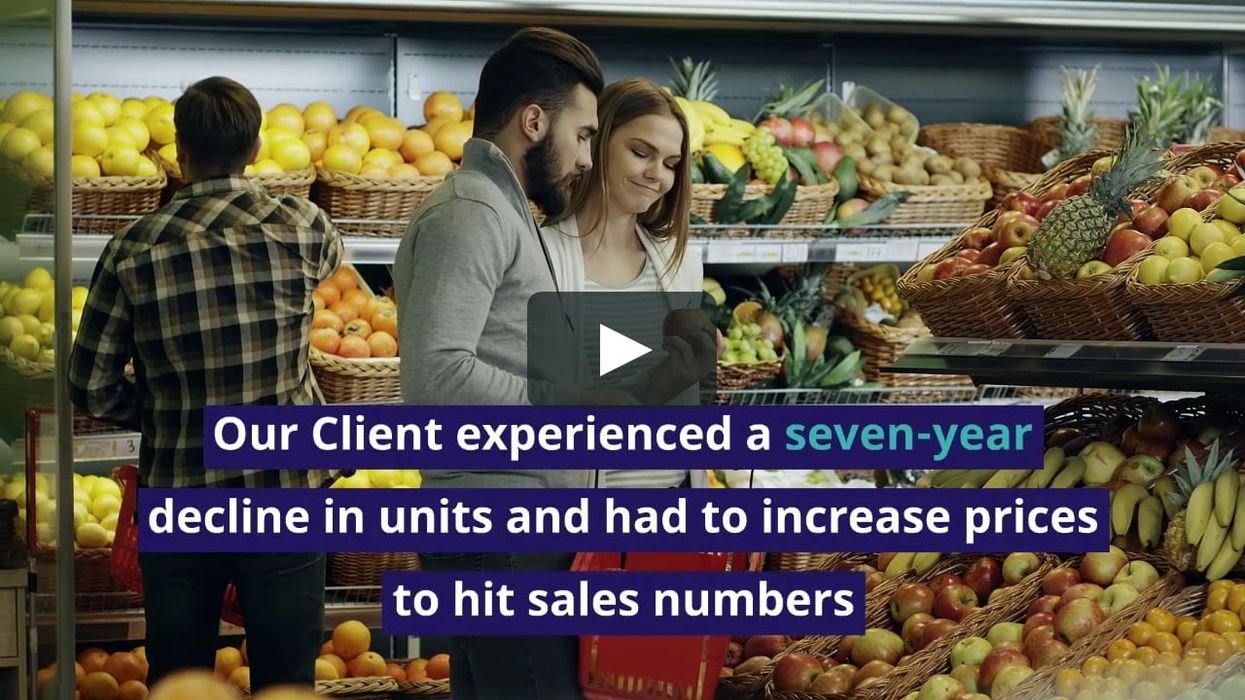In order to reflect on how the grocery world changed in 2020, we have changed how we calculate our overall Grocery RPI score. Given the historically unique metrics we've witnessed in the economy, the restaurant industry and the grocery industry, along with the rare influence a global pandemic has brought to consumer behavior, we're viewing grocery success in 2020 through a different lens than we viewed grocery success in prior years.
View Full Report
FOR RETAILERS
Smarter operations and sustainable growth, powered by Customer Data Science.
FOR BRANDS
Better understand and activate your Shoppers to grow sales.
Prophets of Aisle Six, Episode 2: Heinen’s Fine Foods
The Prophets of Aisle Six is the first online reality series focusing on innovation in the food retail industry. In this episode, Jose Gomes, dunnhumby's North America Managing Director, travels to the downtown Cleveland store of Heinen's Fine Foods. Jose meets with Tom and Jeff Heinen, co-owners and brothers, and learns how they are evolving their grandfather's mission of delivering excellent customer service. With 23 stores in Northeast Ohio and the greater Chicago area, and a 90-year legacy, Heinen's is proving that being a small retailer can be an advantage when it comes to data.
In this series, dunnhumby tours the globe and speaks with some of the world's greatest brands, exploring their biggest challenges and how they are using customer data science to meet those challenges.
assorted fruits at the market
In the decade since Richard Thaler and Cass Sunstein's Nudge: Improving Decisions About Health, Wealth and Happiness was published, nudge theory has enjoyed unprecedented success.
Predicated on the idea that individuals respond better to indirect suggestion than outright commands, nudge theory is commonly used as a way of subtly influencing our behaviour towards positive choices. The idea has gained such traction, in fact, that many governments around the world have created "nudge units" in a bid to tackle thorny issues like obesity and the climate emergency.
Just as governments are exploring how nudge theory can be used to tackle real-world challenges, retailers have a similar opportunity with regard to their customers' dietary choices. With even a few small changes, retailers can help to nudge shoppers in the direction of healthier food decisions.
What follows are some of my favourite nudges that grocery retailers could easily implement to aid customer health.
Tackle the temptation of treats
In 2018[1], scientists published their findings from a seminal experiment in which some of the UK's leading retailers removed snacks and confectionery from the checkout. Purchases of sweets, chocolate, and crisps subsequently fell by 76% when compared to supermarkets that kept those items in place. In other words, just changing the location of products can nudge shoppers into healthier decision making.
Give healthier goods more space in-store
In 2012[2], scientists investigated whether the sale of healthy snacks next to the checkout in a hospital canteen could be influenced by the amount of shelf space they were allocated. Healthy products were given a quarter of the shelf space in the first test, and three-quarters in the second, with sales rising from just 14% to 44% as a result. Visible availability of healthier options clearly plays a big role in pushing us towards them.
Create dedicated “fruit and vegetable” partitions in trolleys
One particularly innovative nudge was discovered by a group of US scientists in 2017[3], who found that introducing an area in a trolley specifically for fruit and vegetables led to higher sales of those items. As with the previous example, the amount of space dedicated also had a role to play. In one study, increasing the size of the partition from 35% to 50% of the trolley increased customer spend on fruit and veg from $14.97 to $17.54.
Normalising fruit and veg purchases
Change4Life is a campaign run by the UK's Department of Health, aimed at nurturing healthier lifestyles. A 2015 study[4] commissioned as part of the campaign suggests that "normalising" the purchase of fruit and veg goes a long way towards influencing shoppers. When trolleys used statistics showing how many other shoppers purchased fruit and veg, spend in those categories rose by 12.4%. Social norm communications like this are a classic form of nudge that exploits our deep-seated concept of conformity (in this case in a very positive way!).
Use cartoon characters to encourage healthy eating amongst children
Obesity isn't just a problem for adults. To help tackle childhood obesity, the Food Dudes[5] programme put cartoon role models at the centre of its in-school campaigns. One London-based study found that fruit consumption amongst the poorest eaters increased from 4% to 68%, while an unexposed control group showed no change. Whilst this may not show increased consumption in a retail context, the concept of using accessible and entertaining imagery and characters to promote healthy eating out of store should be equally applicable in-store.
The new nudge on the block
Some of these techniques came together last year when the Royal Society for Public Health showcased Nudge, a pop-up at The People's Supermarket in London[6]. While the store was only open for two days, the purchase of sugary drinks was halved according to customer feedback. There are plans to make Nudge a permanent feature of the store, and to use data from every purchase to help identify further opportunities to influence customers towards healthier choices.
And new nudges are always popping up. In November 2019 a new DnaNudge shop opened in London. Combining a wristband and app, DnaNudge aims to help users make better food shopping choices based on their DNA and lifestyle. Food is scanned using the wristband, which will then flash red or green based on its suitability for the owner's biological profile. A product with high salt content will flash red for a user with high blood pressure, for instance. DnaNudge, which recently showcased at CES 2020, is collaborating with Waitrose to study the effects of this approach on pre-diabetic customers.
Keeping up with the PACE
Food labels themselves can be also used to encourage healthy eating, by translating calories into walking time to nudge people into healthier choices. This approach is often called Physical Activity Calorie Equivalent, or 'PACE' labelling, and has shown promise in reducing the number of calories and the amount of food consumed by the public[7]. Some results in the UK have been so promising that the Royal Society for Public Health has called for PACE labelling to be introduced. Despite further research needed to assess its real-world impact, this nudge is likely to receive more attention in the near future.
Nudging us towards a healthier future
It's a sad fact that non-communicable diseases (such as heart disease, cancer and diabetes) still account for around 70%[8] of global deaths. Furthermore, many of these deaths are due to factors that the victim may be able to influence, with tobacco use, alcohol abuse, diet, and inactivity all contributing to that number.
While grocery retailers might not have a direct responsibility for commanding their customers to eat better, they do have the opportunity to play a huge role. As behavioural science becomes better-known around the world and savvy customers expect retailers to make it easier for them to make healthier choices, expect a tipping point soon at which the nascent nudge becomes the new normal.
References
- Supermarket policies on less-healthy food at checkouts, PLoS Med (2018)
- Healthy snacks at the checkout counter, BMC Public Health (2012)
- Larger partitions lead to larger sales Journal of Business Research (2017)
- Shopper marketing nutrition interventions Prev Med Rep (2015)
- 'Food Dudes': Increasing Children's Fruit and Vegetable Consumption. Cases in Public Health Communication & Marketing (2009)
- Health on the Shelf report, Royal Society for Public Health (2019)
- https://www.lboro.ac.uk/media-centre/press-releases/2019/december/labelling-foods-amount-of-physical-activity-needed/
- https://www.who.int/news-room/fact-sheets/detail/noncommunicable-diseases
Retail success takes many forms in today's dynamic marketplace. From large legacy retailers to disruptive start-ups and all manner of competitors in between, the paths to retail success involves common principals around which there is a wide variation of understanding and execution.
To bring clarity to the issue of what makes a winner, dunnhumby, the global customer data science firm, conducted a massive survey of more than 7,000 U.S. shoppers for the second annual Retailer Preference Index (RPI), the first study of its kind in the industry. In what's quickly become known as retailing's equivalent of research firm Gartner's often-cited Magic Quadrant, dunnhumby's RPI is a ranking of more than 50 large food and consumable retailers based on a combination of shopper sentiment and financial performance.
Join Retail Leader and dunnhumby's Grant Steadman, SVP of Client Services, and Erich Kahner, Associate Director of Strategy, for a deep dive into the RPI, the levers for success, and an unvarnished look at why some retailers win and others don't.
Topics discussed include:
- The 7 drivers of consumer preference and what's changed.
- Understanding the RPI methodology.
- How retail winners make emotional connections.
- The new rules of value perception, key drivers and amplifiers.
- The three things RPI laggards must do to improve their appeal to shoppers.
For a look at the retailer rankings and to understand how your business can benefit from implementing the RPI success framework, watch our webinar which took place on Thursday, September 5, 2019.

